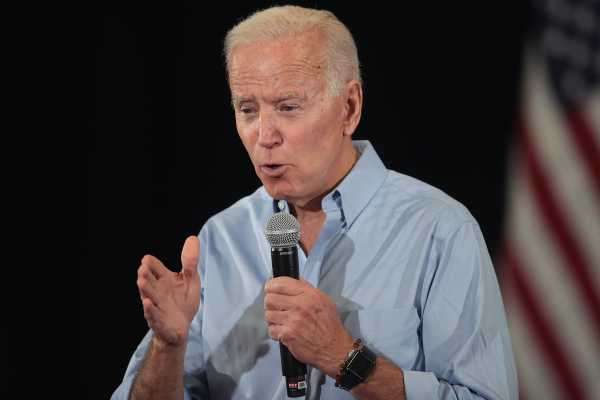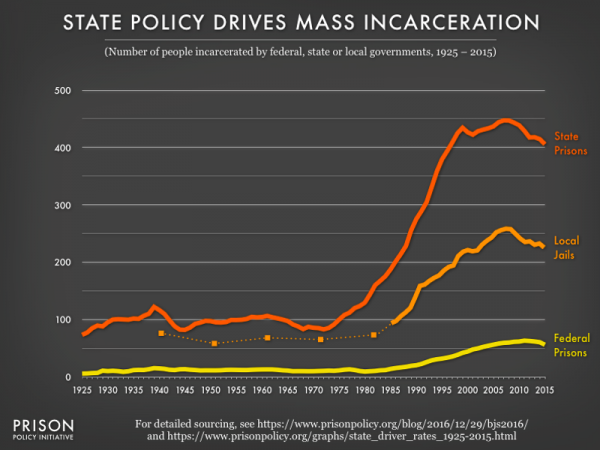
Part of
Vox’s guide to where 2020 Democrats stand on policy
One of the most controversial criminal justice issues in the 2020 election may be a “tough on crime” law passed 25 years ago — and authored by Democratic presidential nominee Joe Biden.
If you ask some criminal justice reform activists, the 1994 crime law passed by Congress and signed by President Bill Clinton, which was meant to reverse decades of rising crime, was one of the key contributors to mass incarceration in the 1990s. They say it led to more prison sentences, more prison cells, and more aggressive policing — especially hurting Black and brown Americans, who are disproportionately likely to be incarcerated.
If you ask Biden, that’s not true at all. The law, he’s argued on the campaign trail, had little impact on incarceration, which largely happens at the state level. As recently as 2016, Biden defended the law, arguing it “restored American cities” following an era of high crime and violence.
The truth, it turns out, is somewhere in the middle.
The 1994 crime law was certainly meant to increase incarceration in an attempt to crack down on crime, but its implementation doesn’t appear to have done much in that area. And while the law had many provisions that are now considered highly controversial, some portions, including the Violence Against Women Act and the assault weapons ban, are fairly popular among Democrats.
That’s how politicians like Biden, as well as previous Democratic rivals like Sen. Bernie Sanders (I-VT), can now justify their votes for the law — by pointing to the provisions that weren’t “tough on crime.”
But with Biden’s criminal justice record coming under scrutiny as he runs for president, it’s the mass incarceration provisions that are drawing particular attention as a key example of how Biden helped fuel the exact same policies that criminal justice reformers are trying to reverse. And while Biden has released sweeping criminal justice reform plans that aim to, in some sense, undo the damage of policies he previously championed, Biden’s history has led to skepticism among some progressives and reformers.
Now, with Tuesday’s presidential debate looming, the 1994 law may be another way for President Donald Trump to attack Biden as Trump tries to spin his own punitive criminal justice record positively.
The 1994 crime law had a lot in it
The Violent Crime Control and Law Enforcement Act, now known as the 1994 crime law, was the result of years of work by Biden, who oversaw the Senate Judiciary Committee at the time, and other Democrats. It was an attempt to address a big issue in America at the time: Crime, particularly violent crime, had been rising for decades, starting in the 1960s but continuing, on and off, through the 1990s (in part due to the crack cocaine epidemic).
Politically, the legislation was also a chance for Democrats — including the recently elected president, Bill Clinton — to wrestle the issue of crime away from Republicans. Polling suggested Americans were very concerned about high crime back then. And especially after George H.W. Bush defeated Michael Dukakis in the 1988 presidential election in part by painting Dukakis as “soft on crime,” Democrats were acutely worried that Republicans were beating them on the issue.
Biden reveled in the politics of the 1994 law, bragging after it passed that “the liberal wing of the Democratic Party” was now for “60 new death penalties,” “70 enhanced penalties,” “100,000 cops,” and “125,000 new state prison cells.”
The law imposed tougher prison sentences at the federal level and encouraged states to do the same. It provided funds for states to build more prisons, aimed to fund 100,000 more cops, and backed grant programs that encouraged police officers to carry out more drug-related arrests — an escalation of the war on drugs.
At the same time, the law included several measures that would be far less controversial among Democrats today. The Violence Against Women Act provided more resources to crack down on domestic violence and rape. A provision helped fund background checks for guns. The law encouraged states to back drug courts, which attempt to divert drug offenders from prison into treatment, and also helped fund some addiction treatment.
All of this was an old-school attempt to attract votes from lawmakers who otherwise might be skeptical, and it succeeded at winning over some Democrats. Bernie Sanders, for one, criticized an earlier version of the bill, written in 1991 but never passed, for supporting mass incarceration, quipping, “What do we have to do, put half the country behind bars?” But he voted for the 1994 law, explaining at the time, “I have a number of serious problems with the crime bill, but one part of it that I vigorously support is the Violence Against Women Act.”
Biden also opposed some parts of the law, even while he helped write it. In 1994, he reportedly called a three-strikes provision — that escalated prison sentences up to life for some repeat offenses — “wacko” and illustrative of Congress’s “tough on crime” attitude.
But Biden and other Democratic authors of the law were clear about their intentions: supporting a more punitive criminal justice system to rebuke criticisms that they were “soft on crime.” (The legislation wasn’t enough for some Republicans in Congress, who complained the bill included too much social spending and pledged to pass tougher laws as part of their 1994 campaign to take back the House.) On the website for his 2008 presidential campaign, Biden referred to the 1994 crime law as the “Biden Crime Law” and bragged that it encouraged states to effectively increase their prison sentences by paying them to build more prisons.
Asked about Biden’s support for the law, the Biden campaign pointed to provisions like the Violence Against Women Act, the 10-year assault weapons ban, firearm background check funding, money for police, support for addiction treatment, and a “safety valve” that let a limited number of low-level first-time drug offenders avoid mandatory minimum sentences. They also cited some of his past criticisms of punitive sentences, including the three-strikes measure, and pointed out that a Republican-controlled Congress later cut funding drastically for drug courts.
In a 2016 interview with CNBC, Biden said that there were parts of the law he’d change, but argued that “by and large what it really did, it restored American cities.” (Although crime has dropped since the ’90s, the research suggests punitive criminal justice policies played at best a small, partial role in that decrease.)
Biden also took credit for the law: “As a matter of fact, I drafted the bill, if you remember.”
The 1994 law didn’t really cause mass incarceration
In a 2020 context, the 1994 law has been criticized for contributing to mass incarceration. This goes back to at least 2016, when activists and writers like Michelle Alexander, author of The New Jim Crow, cited the law to criticize Hillary Clinton’s presidential campaign.
Facing these kinds of criticisms, Biden has argued that the 1994 law, as a federal statute, couldn’t have caused mass incarceration. He argued in May, “Folks, let’s get something straight: 92 out of every 100 prisoners end up behind bars are in a state prison, not a federal prison. This idea that the crime bill generated mass incarceration — it did not generate mass incarceration.”
This is a bit of a dodge as to whether the bill intended to increase incarceration, but Biden is generally correct that the bill, despite its intentions, didn’t actually succeed at expanding incarceration much.
Beyond the changes to hike federal penalties, the 1994 law attempted to encourage states to adopt harsher criminal justice policies. It provided money for states to build prisons and adopt “truth in sentencing” laws that increase prison sentences by requiring inmates to serve out at least 85 percent of their prison sentences without an early release. It’s here where the law could have had most its impact on incarceration — since, as Biden indicated, nearly 88 percent of inmates are held at the state level.
Yet evaluations of the 1994 crime law suggest these state-level provisions didn’t really work out. The 1994 law led only a few states to adopt harsher criminal justice policies, and the tougher policies the 1994 law encouraged weren’t the only measures that fueled mass incarceration overall.
A 1998 report by the Government Accountability Office (GAO), for which federal investigators talked to state officials about whether the 1994 law influenced state policies, noted that just four states adopted “truth in sentencing” laws (TIS) solely as a response to the 1994 law:
Why did most states apparently not take much direction from the 1994 law? Many state officials said they were already interested in “tough on crime” measures before the federal law, GAO investigators found:
Some state officials also argued that the funding incentives were too small to drive big policy changes. Vermont, for instance, said meeting the federal requirements for “truth in sentencing” would cost several million dollars but only result in about $80,000 in federal grants.
A more recent report, published by the National Institute of Justice in 2002, produced similar findings: “Overall, Federal TIS grants were associated with relatively few State TIS reforms. There was relatively little reform activity after the 1994 enactment of the Federal TIS grant program, as many States had already adopted some form of TIS by that time.”
“Truth in sentencing” laws were also only one way that federal and state governments embraced mass incarceration. They also flat-out increased prison sentences, adopted harsh mandatory minimum sentences, and encouraged police and prosecutors to be tougher on criminals — most of which happened separately from the 1994 law.
That’s reflected in the statistics, which show that incarceration rates were climbing rapidly before the 1994 crime law and actually started leveling off a few years after.

This is relevant to Democratic attempts to reverse mass incarceration, too. For example, Sen. Cory Booker (D-NJ), who previously ran for president, has introduced a bill that would encourage states, with financial incentives, to cut back incarceration — a sort of antonym to the 1994 crime law. But as Fordham Law School criminal justice expert John Pfaff wrote for Vox, the approach overstates “the role of federal policy in expanding state prison populations” and “the role federal policy might play in reducing those populations.”
In this way, a clear reading of the 1994 law’s actual effects is very relevant not just to Biden’s politics, but to criminal justice reformers’ efforts to undo mass incarceration.
Still, the 1994 law reflects Biden’s “tough on crime” history
Whatever the effects of the 1994 crime law and Biden’s reasons for supporting it, it is only one piece of Biden’s much longer history backing “tough on crime” policies that at the very least attempted to escalate incarceration nationwide.
Here are some examples from his record, drawn partly from Jamelle Bouie’s previous rundown at Slate:
- Comprehensive Control Act: This 1984 law, spearheaded by Biden and Sen. Strom Thurmond (R-SC), expanded federal drug trafficking penalties and civil asset forfeiture, which allows police to seize and absorb someone’s property — whether cash, cars, guns, or something else — without proving the person is guilty of a crime.
- Anti-Drug Abuse Act of 1986: This law, sponsored and partly written by Biden, ratcheted up penalties for drug crimes. It also created a big sentencing disparity between crack and powder cocaine; even though the drugs are pharmacologically similar, the law made it so someone would need to possess 100 times the amount of powder cocaine to be eligible for the same mandatory minimum sentence for crack. Since crack is more commonly used by Black Americans, this sentencing disparity helped fuel big racial disparities in incarceration.
- Anti-Drug Abuse Act of 1988: This law, co-sponsored by Biden, increased prison sentences for drug possession, enhanced penalties for transporting drugs, and established the Office of National Drug Control Policy, which coordinates and leads federal anti-drug efforts.
Just as with his comments around the 1994 law, Biden was also explicit about what his goals were with these other measures. In 1989, at the height of punitive anti-drug and mass incarceration politics, Biden even went on national television to criticize a plan from President George H.W. Bush to escalate the war on drugs. The plan, Biden said, didn’t go far enough.
“Quite frankly, the president’s plan is not tough enough, bold enough, or imaginative enough to meet the crisis at hand,” he said. He called for harsher punishments for drug dealers and to “hold every drug user accountable.” Bush’s plan, Biden added, “doesn’t include enough police officers to catch the violent thugs, not enough prosecutors to convict them, not enough judges to sentence them, and not enough prison cells to put them away for a long time” — a direct call for more incarceration.
All of this reflected a broader movement in the Democratic Party to address the growing issue of crime and overcome successful Republican attacks about how Democrats are “soft on crime.” This helps explain not just why Biden said and did all these things, but why Bill Clinton signed the 1994 crime law and ran on its “tough on crime” provisions — including his support for the “death penalty for drug kingpins” — during his reelection bid in 1996.
Biden has repented for some of his past, acknowledging that creating extra punitive penalties for crack was “a big mistake” and supporting efforts to reel back those penalties. “I haven’t always been right,” Biden said earlier this year, speaking to criminal justice issues. “I know we haven’t always gotten things right, but I’ve always tried.”
As part of his presidential campaign, Biden has also released sweeping criminal justice reform proposals. Among many measures, he has promised to fund police reforms, decriminalize marijuana, eliminate mandatory minimum sentences for nonviolent crimes, end the death penalty, abolish private prisons, get rid of cash bail, and discourage the incarceration of children.
Biden is also now running against Trump, who still proudly calls himself “tough on crime” and continues to push for tougher prison sentences, more aggressive police tactics, and wider use of the death penalty. While Trump signed criminal justice reform in the First Step Act, it appeared to be a political favor and a weak attempt to win over minority voters, not a genuine change of heart. And Trump’s administration has undermined the law, with federal prosecutors actively resisting the release of some inmates who qualify under the First Step Act. If the choice is between Biden and Trump, Biden is clearly better for reform.
Still, Biden’s record remains a concern for reformers. A big worry in the criminal justice reform space is what would happen if, say, the crime rate started to rise once again. If that were to happen, there could be pressure on lawmakers — and it’d at least be easier for them — to go back to “tough on crime” views, framing more aggressive policing and higher incarceration rates in a favorable way.
Given that the central progressive claim is that these policies are racist and, based on the research, ineffective for fighting crime in the first place, any potential for backsliding in this area once it becomes politically convenient is very alarming.
The concern, then, is what would happen if crime started to rise under President Biden: Would he fall back on old “tough on crime” instincts, calling for harsh prison sentences once again?
“[E]ven if Biden has subsequently learned the error of his ways,” Branko Marcetic wrote for Jacobin, “the rank cynicism and callousness involved in his two-decade-long championing of carceral policies should be more than enough to give anyone pause about his qualities as a leader, let alone a progressive one.”
That’s what the debate over the 1994 crime law is about. It’s not just that Biden messed up by helping write and supporting the law a quarter-century ago, but what his involvement says about him today and in the future.
Help keep Vox free for all
Millions turn to Vox each month to understand what’s happening in the news, from the coronavirus crisis to a racial reckoning to what is, quite possibly, the most consequential presidential election of our lifetimes. Our mission has never been more vital than it is in this moment: to empower you through understanding. But our distinctive brand of explanatory journalism takes resources. Even when the economy and the news advertising market recovers, your support will be a critical part of sustaining our resource-intensive work. If you have already contributed, thank you. If you haven’t, please consider helping everyone make sense of an increasingly chaotic world: Contribute today from as little as $3.
Sourse: vox.com





